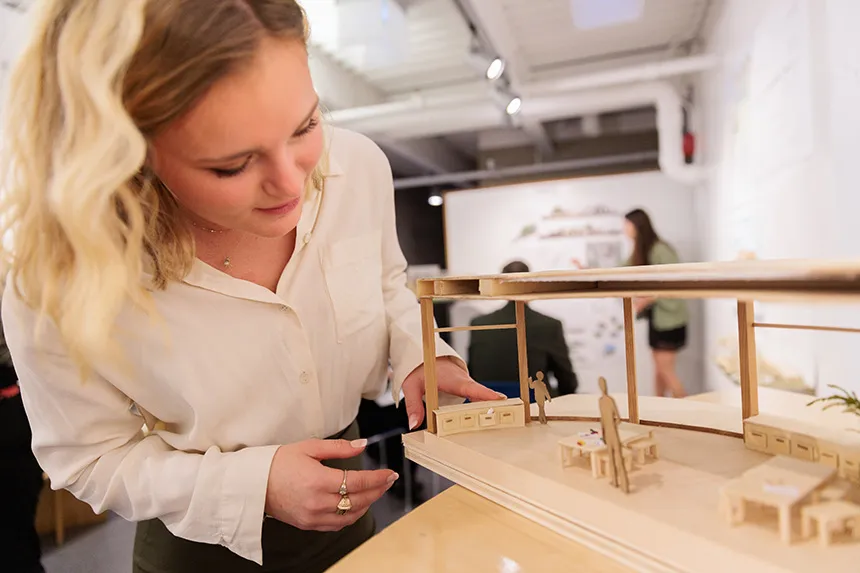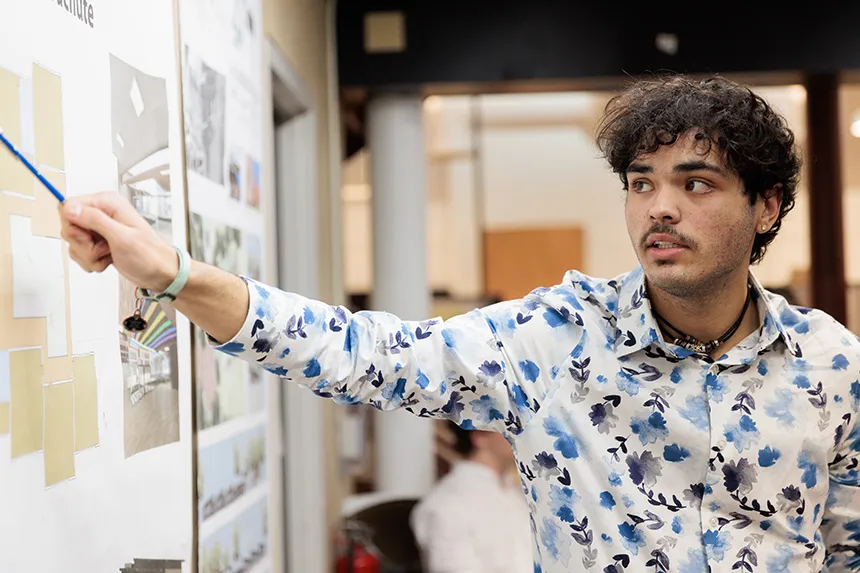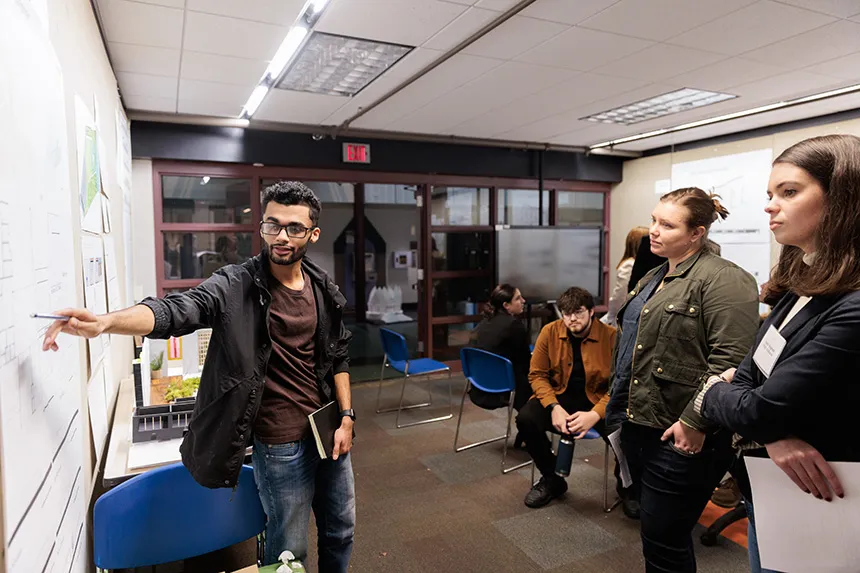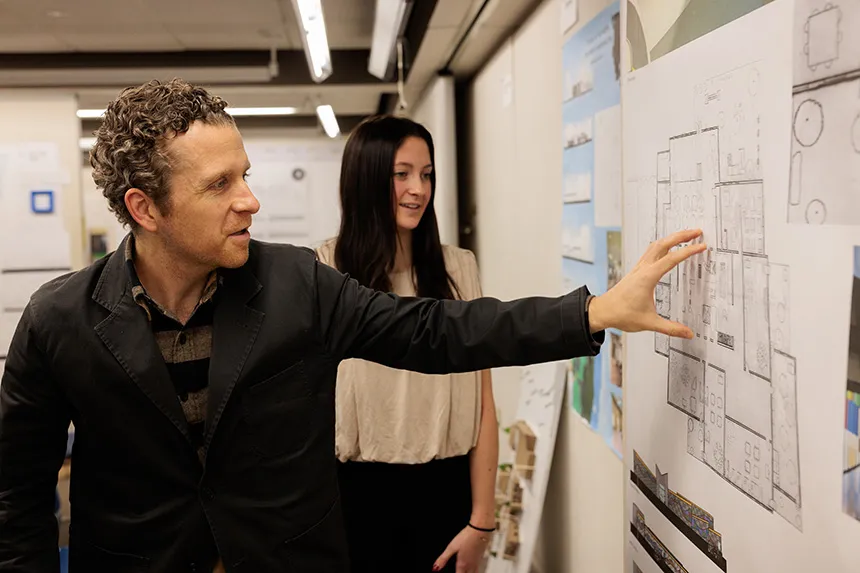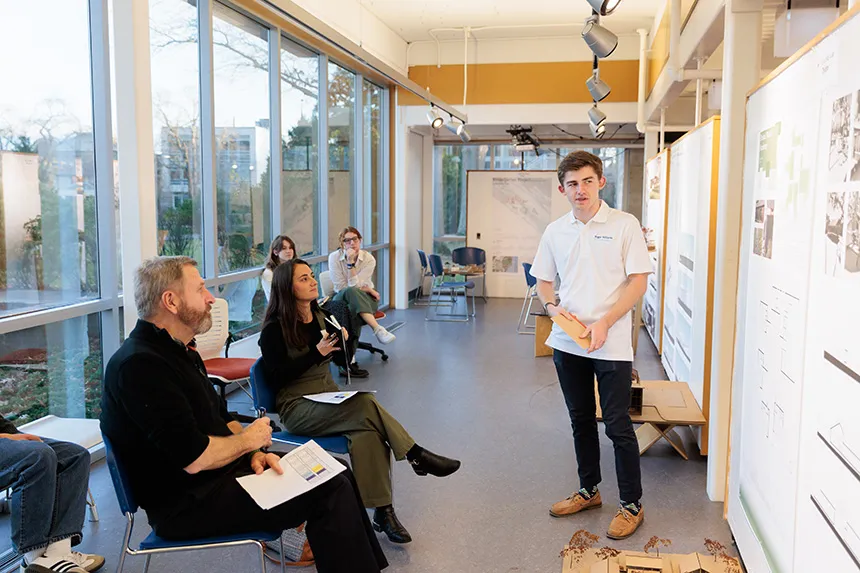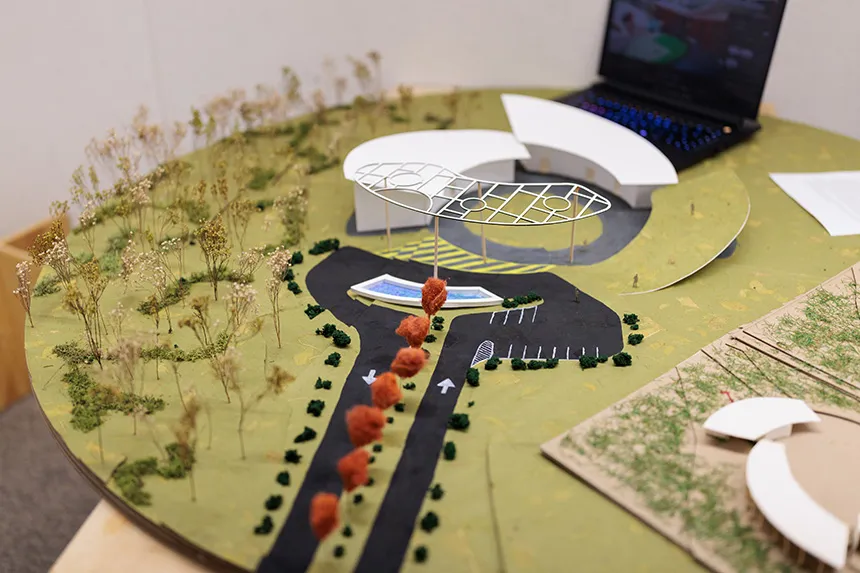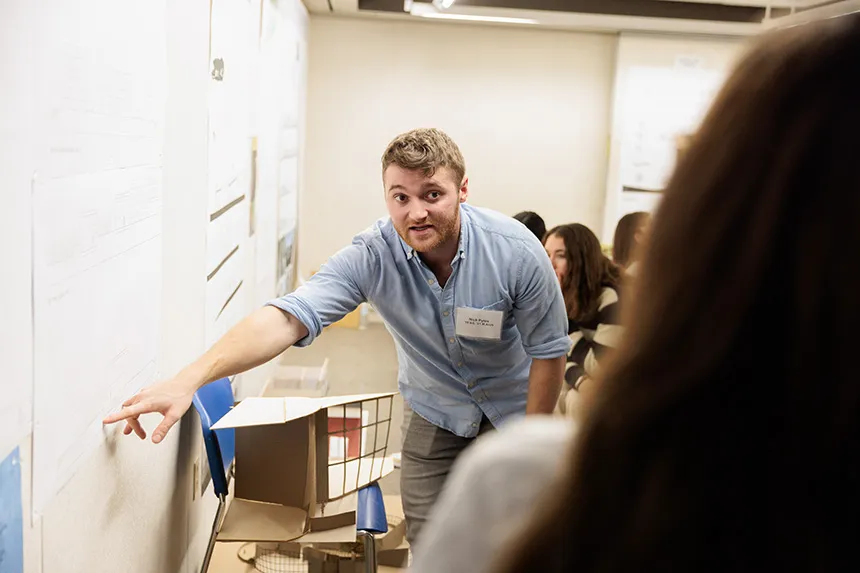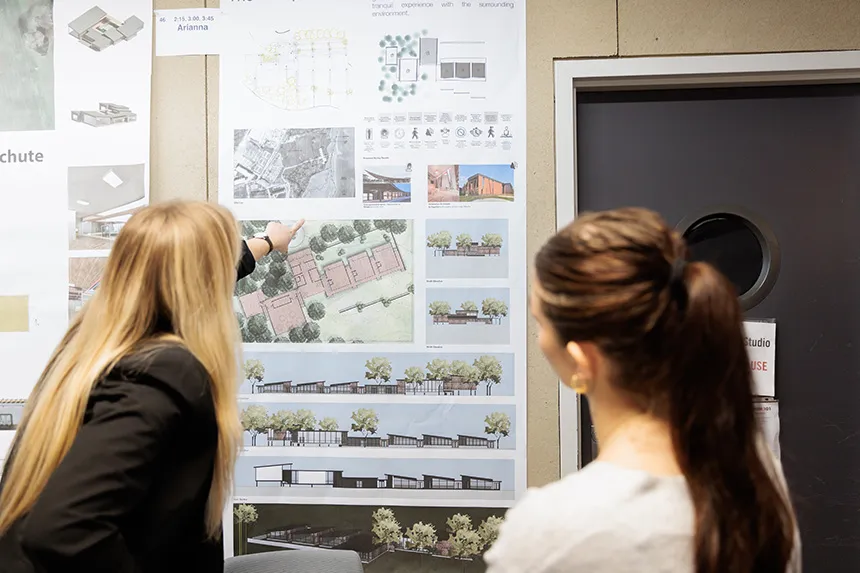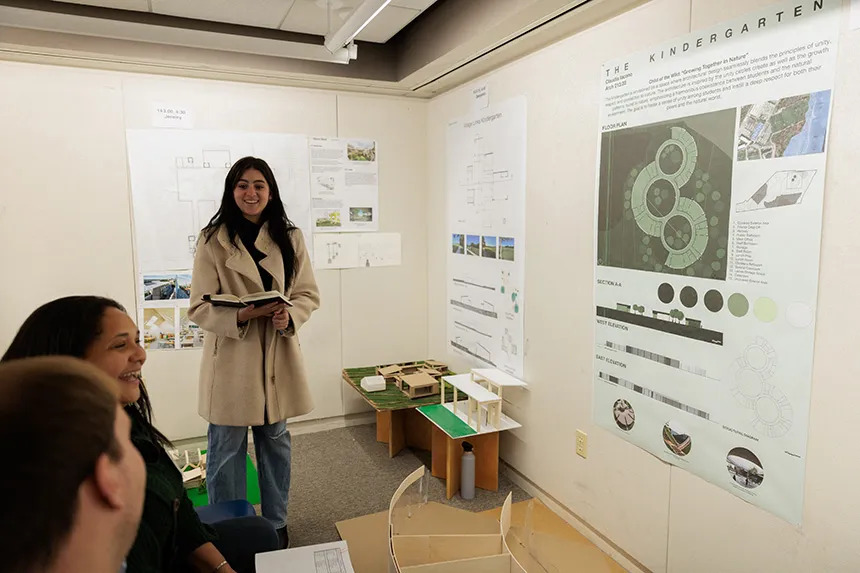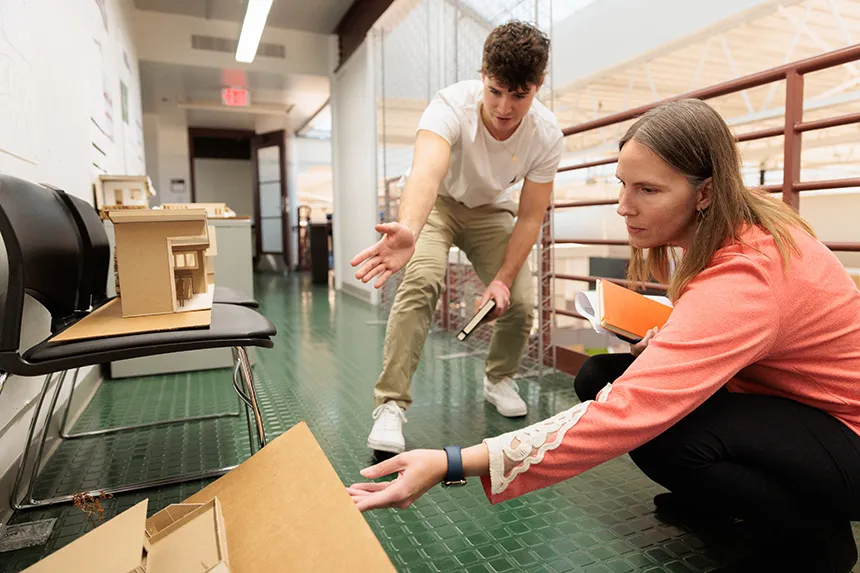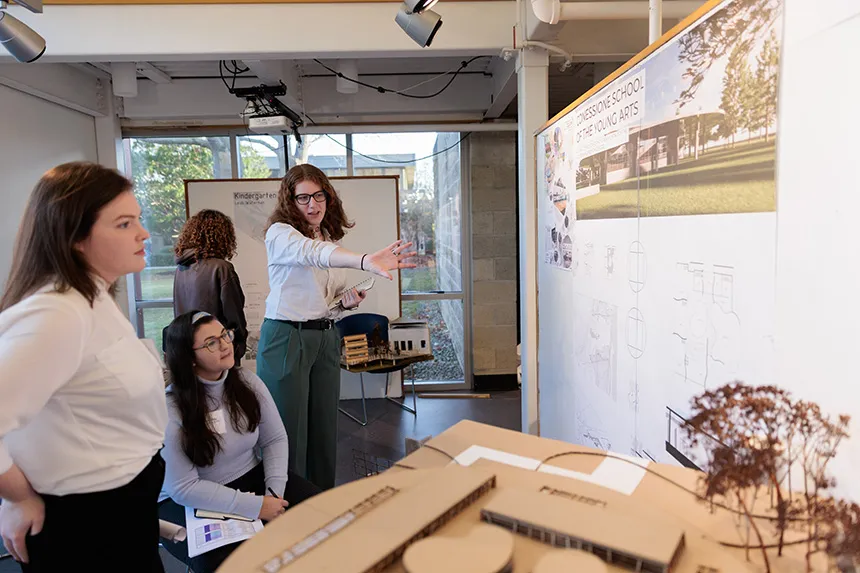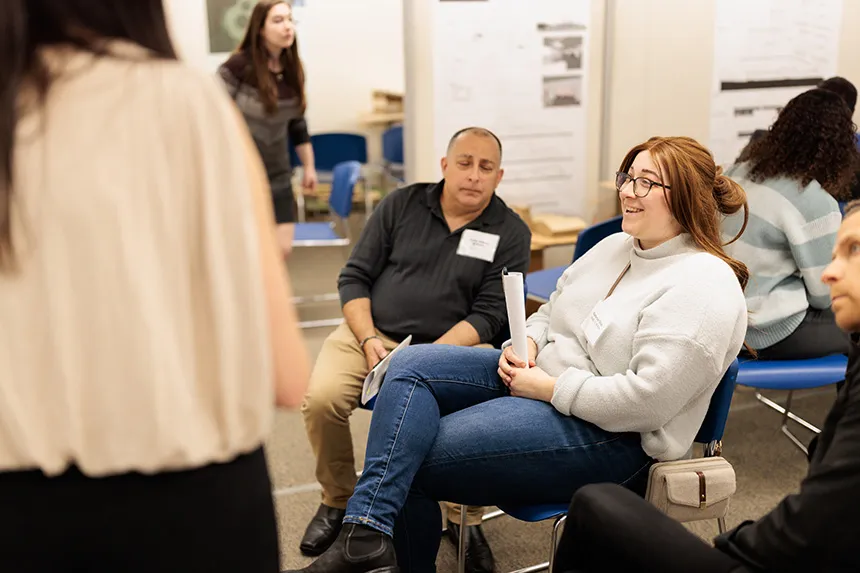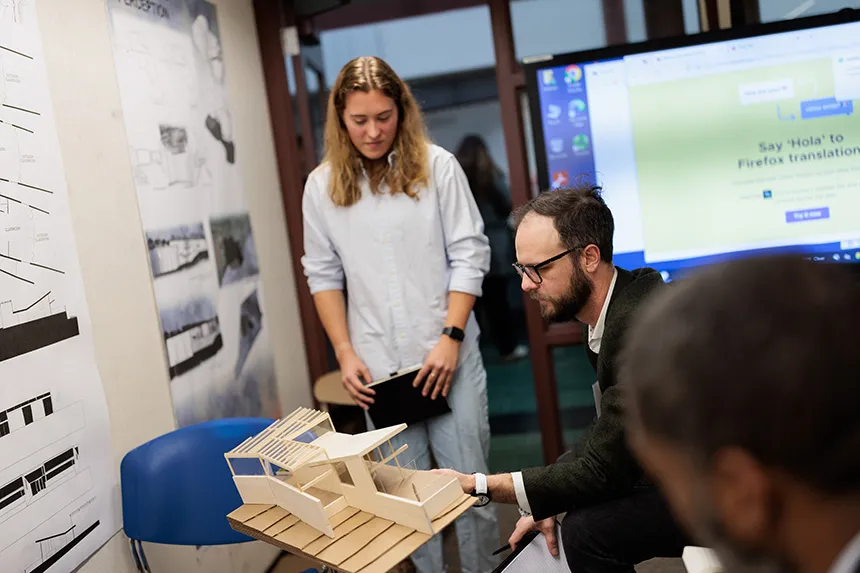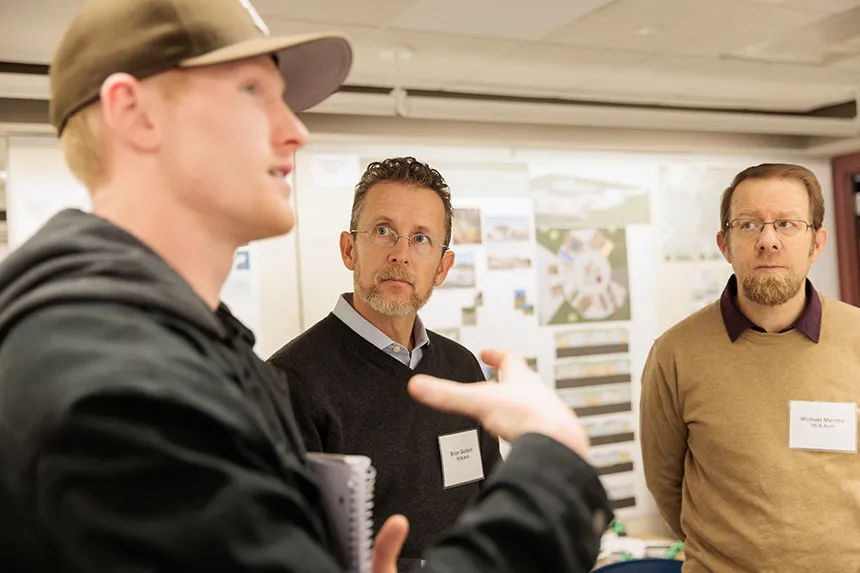Bridging Generations: RWU Architecture Alumni Inspire the Next Wave of Designers
In an unprecedented studio review, 38 alumni returned to the Cummings School of Architecture to offer their critiques and advice to 96 undergraduate Architecture students
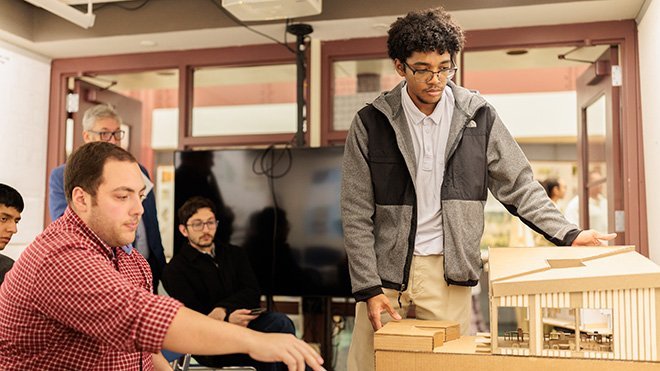
BRISTOL, R.I. – In a poignant blend of tradition and innovation, the Roger Williams University Cummings School of Architecture echoed with the spirit of a homecoming last month as 38 distinguished Architecture alumni, driven by a shared passion for their alma mater, returned to offer their advice and feedback to 96 Architecture students.
During the unprecedented event for the School of Architecture, the school’s glass-walled vestibule and gallery filled with the smiling faces of practicing and aspiring architects on Dec. 11. The space transformed into a scene of joyous reunions, with warm embraces of camaraderie between alumni and professors, in a celebratory moment where the past intertwined with the present to shape the futures of current RWU students.
The brainchild of Gregory Laramie, Associate Dean of the Cummings School of Architecture, the gallery-style studio review brought together more than three dozen alumni from across the region to critique students’ final design projects. The event was a well-orchestrated affair, with alumni paired together and assigned six projects to assess in 15-minute increments over two hours. Each student presented their designs, provided an overview of their buildings and explained their thought process using detailed schematics. In return, alumni provided professional feedback, highlighting commendable aspects of the plans and offering constructive advice where needed.
Stephen White, Dean of the Cummings School of Architecture, noted that the school has never before seen so many alumni participate in a studio review and that this event is part of an overall effort to engage more graduates in the school. “There is such a spirit of community in this building, and the fact that so many people were willing to come back after so many years shows that,” he said. “One of the great things about an event like this is that it encourages students to look at things from multiple perspectives and to undertake feedback from different sources. The input that our students are getting from our fantastic alumni is first-rate.”
As part of the review, the third-semester Architecture students enrolled in one of two studio courses were presented with a theoretical challenge of designing a kindergarten with specified parameters, to be built at the Bristol campus’s former lacrosse and rugby fields. The students’ designs explored the intricacies of a building's relationship to its site, the development of spatial qualities, and the nuances of architectural detail. They began by creating an idea board and then shifted to site design, facility layout, and detailed proposals with large-scale dioramas. The review process challenged students to consider cohesiveness within the broader design narrative. As White said, the in-person event allowed for a lot of interaction and conversations to flourish between students and reviewers.
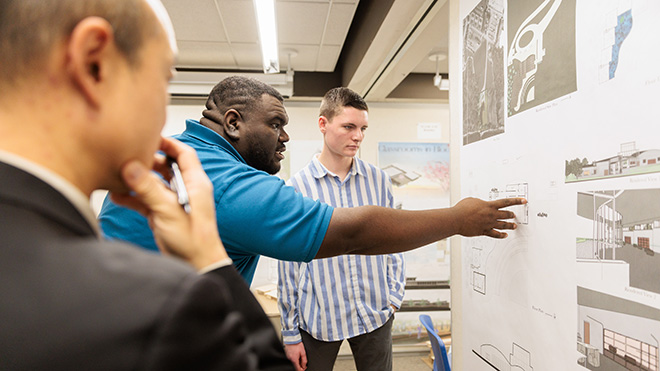
Driven by a strong desire to help foster the growth of budding architects, Kejon Sampson M ’17, a job captain at DBVW Architects in Providence, R.I., said this year’s review process stood as a testament to the cyclical nature of learning, where the foresight gained from decades of collective professional endeavors came full circle to enrich the educational experiences of a new generation. Originally from Bermuda, Sampson’s most profound piece of advice for students was to value perspective and remember who you are building for.
“It feels good to be able to give my knowledge to students because I didn't have anybody to get that information from when I was younger. Now that I have that information, I gladly pass it on to them,” Sampson said. “[These students] are clearly able to express their thoughts and ideas about design, and that's where it all starts. This is the fundamental part of everything that they will do.”
For sophomore Keon Coleman, an Architecture major with minors in Preservation Studies and Construction Management from Stanford, Conn., Sampson’s advice rang especially true. “Kejon understood that as a second-year student I am in the early stages of becoming an architect,” Coleman said. “It felt nice to talk with someone who was recently in my shoes but also has been through a lot more than me.”
Junior Dylan Steward, an Architecture major with a minor in Construction Management from Bedford, N.H., said he was grateful to hear advice from alumni. “I really appreciate feedback from professors, especially those who have been around for a while, but it's also refreshing to have reviewers who had the same teachers that I have, similar experiences, and who have been influenced by the same people. I felt like we could relate a lot better.”
Steward, whose kindergarten design featured a tapestry of elements focused on promoting community and using local natural materials, said the conversations he had with alumni will influence his remaining time at RWU and his career.
“After all the feedback about how this project turned out, it was worth all the time I put into it,” he said. “I'm going to use these same skills and approaches for all my future projects in my career. Perhaps when I get assigned a project like this, I'll go to where the site is and interview the people who work in a type of building that I'm building, because in the end I’m designing for these people. That's something I really want to incorporate in my future when designing.”
Lauren Irons ’17, M ’19, whose own architecture reviews are hardly a distant memory, applauded the studio review for offering students the opportunity to get personalized feedback on their designs. “We only did this gallery-style [review] in our graduate program. It’s nice to introduce this style earlier because it’s a bit more intimate with each student where you can better hone in on their concepts. That’s something you don’t always get the chance to do in larger settings,” said the architectural designer, who now works for KG+D Architects in Mount Kisco, N.Y.
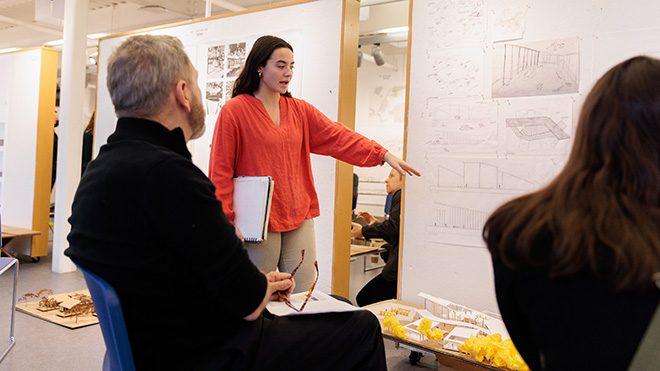
Following the last batch of reviews, it was clear that many students committed to doing their research. Going above and beyond, scholars like sophomore Lauren Canata, an Architecture major with a minor in Art History from West Springfield, Mass., sought input on practical school layouts from two longtime teachers – her parents – and incorporated their knowledge into her design. During Canata’s discussion, one significant takeaway was how the role of school facilitators is constantly changing, especially in the wake of ever-evolving technology. This prompted her to figure out ways her space could be used to ensure kids still have engaging, hands-on experiences in the classroom.
“I really enjoyed this experience. It was a very relaxed atmosphere to make personable connections with alumni who you know were in your shoes not too long ago,” she said. “I talked with a few [alums] about what they are doing now and if they like it, and they do. It gives you a sense that [the future] is going to be fun.”
All in all, the nearly 100 students expressed a great appreciation for the dozens of former scholars who made the trek back to their former studios. For the returning alumni, this is all they could hope for.
Katherine Shea ’19, M ’21, an architectural designer with Mercer Bertsche Vernott Architects in Mystic, Conn., said the event not only underscored RWU’s enduring commitment to provide a holistic and dynamic education but also exemplified the symbiotic relationship between alumni and their academic roots.
“It's such a little family here. I saw 10 of us from my class and it’s just so great to see everyone,” Shea said. On why she wanted to volunteer, she said, “It's so much fun to come back and see how the students are doing because I remember being a second-year [student], and I know it can be a bit chaotic.”
In an era where collaboration and mentorship are increasingly recognized as crucial components of a successful education, RWU's Architecture program stands as a shining example. For those involved in the studio review, they say the impact of this collaborative effort will resonate in future projects, and leaders say they hope this will be an annual tradition.
“It would be great if it was a pattern,” White said. “Normally we would say, ‘No, we can’t do something like this with all these people. We’ll just invite 10.’ But we went for it, and we did it. We see that it works. The School of Architecture is only getting better –and it’s getting better by relating together, pushing forward together, and helping each other.”
